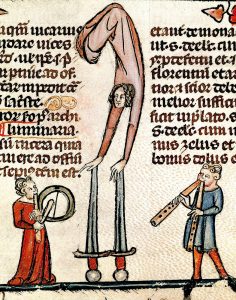“She hadde lerned of minstralcie”
Women entertainers in the Middle Ages:
A study of their status and representation

Early 14th-century picture of a jongleresse balancing on swords. British Library, MS Royal 10 E iv, f. 58. Sourced online, copyright unidentified.
I haven’t looked to see what’s been written about female medieval entertainers in the years since I wrote my Masters thesis. But if you’re interested in the topic, please feel free to get in touch as I’m happy to share a copy of the PDF file. The section on Salome will be of particular interest – and surprise – to those only familiar with Salome’s post-Renaissance portrayals as a dancer. And as for Matilda Makejoy, yes, that truly is her wonderful name!
[Abstract] “Female minstrels or jongleurs (jongleresses) have typically been regarded as marginalised individuals in medieval society, but the present study argues that their status was extremely varied. Although they were generally viewed with suspicion by the Church, jongleresses were welcomed as singers, musicians and tumblers by the nobility and the wider community. Many of the women travelled extensively in the course of their work and were greatly respected and admired by members of the royal courts. As jongleresses and minstrels gravitated to towns and cities in the later Middle Ages, a small number of women also participated in minstrel guilds, especially in the Confrerie of St-Julien des Menestriers in Paris.
Using an eclectic mix of sources including romances, household account rolls, visual images and religious texts, this study examines the representation of jongleresses within different medieval contexts. Chapter One explores the Church’s perceptions of jongleresses and also examines these perceptions in relation to the figure of Salome. Some attention is given to day-to-day interactions between jongleresses and the priesthood. Chapter Two looks at the relationships between women entertainers and medieval society, and challenges the belief that jongleresses were akin to prostitutes. Chapter Three examines the nature of women entertainers’ employment at court and explores their representation in courtly literature. The thesis concludes with a case study of the well-known fourteenth-century tumbler, Matilda Makejoy, who performed for members of the House of Lancaster between 1296 and 1311.”
Department of English and Cultural Studies, University of Melbourne, 2003.
[Contents]
Introduction
i. Approaching the Evidence
ii. A Review of the Literature
Chapter One: Jongleresses and the Medieval Church
1.1 From Roman Mima to Medieval Jongleresse
1.2 Images of Salome
1.3 Bishop Wolfger, Abbot Busse and the Durham Monks
Chapter Two: Women Entertainers in Medieval Society
2.1 Prostitution and the Jongleresse: An Alternative Verdict
2.2 Matters of Status: The Case for the Marginalised Jongleresse
2.3 Minstrel Guilds and the Role of Women
Chapter Three: Jongleresses in the Context of the Court
3.1 Employment at Court
3.2 Courtly Literature, Islam and the Image of the Jongleresse
3.3 Jongleresses and the Decline of Jonglerie
A Case Study: Matilda Makejoy
Conclusion
Bibliography
